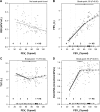A new approach to assess COPD by identifying lung function break-points
- PMID: 26508849
- PMCID: PMC4610777
- DOI: 10.2147/COPD.S86059
A new approach to assess COPD by identifying lung function break-points
Abstract
Purpose: COPD is a progressive disease, which can take different routes, leading to great heterogeneity. The aim of the post-hoc analysis reported here was to perform continuous analyses of advanced lung function measurements, using linear and nonlinear regressions.
Patients and methods: Fifty-one COPD patients with mild to very severe disease (Global Initiative for Chronic Obstructive Lung Disease [GOLD] Stages I-IV) and 41 healthy smokers were investigated post-bronchodilation by flow-volume spirometry, body plethysmography, diffusion capacity testing, and impulse oscillometry. The relationship between COPD severity, based on forced expiratory volume in 1 second (FEV1), and different lung function parameters was analyzed by flexible nonparametric method, linear regression, and segmented linear regression with break-points.
Results: Most lung function parameters were nonlinear in relation to spirometric severity. Parameters related to volume (residual volume, functional residual capacity, total lung capacity, diffusion capacity [diffusion capacity of the lung for carbon monoxide], diffusion capacity of the lung for carbon monoxide/alveolar volume) and reactance (reactance area and reactance at 5Hz) were segmented with break-points at 60%-70% of FEV1. FEV1/forced vital capacity (FVC) and resonance frequency had break-points around 80% of FEV1, while many resistance parameters had break-points below 40%. The slopes in percent predicted differed; resistance at 5 Hz minus resistance at 20 Hz had a linear slope change of -5.3 per unit FEV1, while residual volume had no slope change above and -3.3 change per unit FEV1 below its break-point of 61%.
Conclusion: Continuous analyses of different lung function parameters over the spirometric COPD severity range gave valuable information additional to categorical analyses. Parameters related to volume, diffusion capacity, and reactance showed break-points around 65% of FEV1, indicating that air trapping starts to dominate in moderate COPD (FEV1 =50%-80%). This may have an impact on the patient's management plan and selection of patients and/or outcomes in clinical research.
Keywords: body plethysmography; break-point; impulse oscillometry; severity; single-breath carbon-monoxide diffusion test; spirometry.
Figures




References
-
- World Health Organization (WHO) The top 10 causes of death [web page on the Internet]. Fact sheet number 310. Geneva: WHO; [Accessed March 27, 2015]. nd [updated May 2014]. Available from: http://www.who.int/mediacentre/factsheets/fs310/en/
-
- Soriano JB, Rodriguez-Roisin R. Chronic obstructive pulmonary disease overview: epidemiology, risk factors, and clinical presentation. Proc Am Thorac Soc. 2011;8(4):363–367. - PubMed
-
- Chung KF, Adcock IM. Multifaceted mechanisms in COPD: inflammation, immunity, and tissue repair and destruction. Eur Respir J. 2008;31(6):1334–1356. - PubMed
-
- Sohal SS, Ward C, Danial W, Wood-Baker R, Walters EH. Recent advances in understanding inflammation and remodeling in the airways in chronic obstructive pulmonary disease. Expert Rev Respir Med. 2013;7(3):275–288. - PubMed
MeSH terms
LinkOut - more resources
Full Text Sources
Medical

